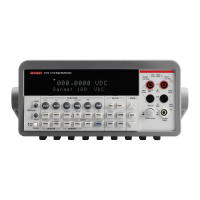4-24 Return to Section Topics 2100-900-01 Rev. D / September 2011
Section 4: Front Panel Operations Model 2100 6 1/2-Digit Resolution Digital Multimeter User’s Manual
CALCulate:FUNCtion AVERage
CALCulate:STATe {OFF|ON}
CALCulate:STATe?
CALCulate:AVERage:MINimum?
CALCulate:AVERage:MAXimum?
CALCulate:AVERage:AVERage?
CALCulate:AVERage:COUNt?
Null
Definition
When the Null function is enabled, the displayed measurement reading is the difference between
the measured input signal reading and the stored null (also called relative) value. The null
(relative) value is stored in volatile memory, which will be cleared when the multimeter is shut off.
You can also specify or alter a null value. The null feature is available for all functions (except
continuity and diode). When you select the null feature for a measurement, it is visible only for one
measurement.
Using the Null (relative) function
You can activate the Null function from either the front panel or a remote interface.
To use the Null function from the front panel:
NOTE Null measurements can be used with any function except continuity and diode.
1. To store the null test lead resistance, short/connect the two test leads together and then
press the NULL key. The new reading taken will replace the old value (if any) in the null
register.
2. Connect the two test leads to the input source. The null offset value will show on the display
(refer to Figure 4-19 for the keys to use).
The null offset value can also be adjusted manually from the front panel:
1. Press CONFIG, then NULL.
2. Use the PREV and NEXT keys to move through the digits, and use the up and down arrow
keys to increase or decrease the numbers to the desired value.
3. Press ENTER.
NOTE Press NULL again to disable this feature. The "MATH" annunciator on the display
indicates the state of a mathematical feature.

